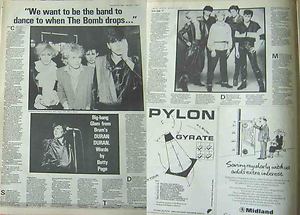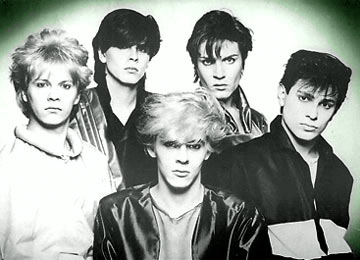In the third extract from my memoir Hit Girl: My Bizarre Double Life in the Pop World of the Eighties, I tell the story of my first encounter with a bunch of young upstarts who would go on to conquer the globe with their aspirational videos, pretty-boy looks and pop-rock tunes. The resulting interview in Sounds, published in December 1980, was the band’s first-ever mainstream press coverage.

After I’d done the big “New Romantics” interview in Sounds I became a magnet for every ruffle-shirted chancer in the country. The letters, demo tapes and grainy snapshots poured in. I’d never seen such a parade of badly applied blusher and sucked-in cheeks.
So, when I received a phone call from the manager of a Birmingham-based band called Duran Duran, I had, understandably, developed a healthy cynicism. But Paul Berrow was a smooth operator. “Come to the Rum Runner,” he said of the club he co-owned with his brother Michael. “We’ve got a scene going on up here to put the Blitz to shame, and a band to go with it.”
Clever, I thought. He had singled me out to be the first journalist to write about his band – and they actually wanted to be called New Romantics (fancy that!). I knew from talking to Blitz guru Steve Strange that there was plenty of fine posing going on in Birmingham and I wanted to investigate it further. On that basis, I agreed to take up Mr Berrow’s kind offer.
The Rum Runner was impressive – smart, spacious and futuristic – unlike most of the clubs London at that time, which were cubicle-sized and decorated with flock wallpaper that hadn’t been replaced since the Sixties.
The Berrow brothers were charming and knew exactly what they were doing, which was packaging a pop band in the fashion of the moment. But they weren’t Svengalis – just a pair of clued-up businessmen who’d found themselves a bunch of smart boys – average age 19 – who all had the potential to become teen idols.
In the beginning, there were three Taylors – John (bass), Andy (guitar) and Roger (drums), joined by Nick Rhodes (keyboards) and Simon Le Bon (vocals). Nick was the most obvious New Romantic – a bouffant blond David Sylvian lookalike who sported frilly shirts and shiny suits – but the style sat rather uncomfortably on the rest of them. The alarmingly pretty, floppy-fringed bassist John drew the line at satin shirts and a shoulder sash.
Simon, a former drama student at Birmingham University who was a little on the podgy side, took up the look enthusiastically but rather theatrically, in velvet and a selection of miniature jingle bells. Andy, whose natural style prefigured Jon Bon Jovi, clearly had to be bribed into wearing a tunic and pixie boots. And the shy but smouldering drummer Roger just looked profoundly embarrassed by it all and stuck to his trusty leather trousers.

I worked out pretty quickly that they were not on the same sartorial planet as Spandau Ballet. Their claim to be a New Romantic band fell down when they took the support slot on a Hazel O’Connor tour – a smart marketing move, but not high on the credibility scale. Duran, however, saw it as a way to reach a wider audience. Not for them the Spandau-style secret gigs to an invited elite.
When I sat down in a back room at the Rum Runner to conduct Duran Duran’s first major interview, I was verbally assaulted. Roger Taylor hardly opened his mouth and Simon Le Bon was suffering from tonsillitis so only made the occasional contribution, but the other three pumped up the volume.
I was taken with Nick Rhodes’s outspokenness and dry sense of humour, but even more so with John Taylor’s self- assurance. On close inspection, he was incredibly handsome, despite the fact that the make-up he was wearing did nothing to improve his good looks.
“We never meant to be bagged in with any elitist scene,” John told me, referencing the Blitz crowd in London. “It happened naturally because we were all into it.”
Nick continued: “We’re not trying to move away from that scene – the main chunk of our audience in Birmingham is those people, but we’re not as tied to it as Spandau Ballet obviously are. When people come to see us we’d much sooner they dance and have a good time rather than dress up in the clothes and just stare.”
Pint-sized, blond-haired Geordie guitarist Andy interrupted: “The scene in Brum was looking for something to latch on to. We weren’t exactly ideal for what they wanted – like right posed-up – but we got through after three or four gigs. The scene here is phenomenal – on Friday night down the Rum Runner, there’s 600 of them. That’s a lot of posers for Birmingham.”
And in those few words he had expressed everything I needed to know about his attitude towards New Romantics (after all, he had answered an ad in Melody Maker for a “livewire guitarist”).
“I don’t think the accent is quite so much on fashion,” said John without batting an eyelid. “If there’s anything lacking here it’s a fashion movement – they’re still quite happy to dress in the old Bryan Ferry tuxedos.”
“We put fashion after music,” said Nick. “We’d never go onstage looking scruffy but regard the whole show – the lights, slides and films – as equally important. We won’t change our attitude to clothes every week.”
As evidenced by the raggle-taggle crew sitting in front of me. Birmingham’s bright young things may have needed some personal style coaching from Steve Strange, but their charming parochialism was clearly more representative of the “little scenes in the great grey places” around the country, from Cardiff to Manchester.
The beauty of these clubs, Rum Runner included, was that people of different persuasions could mix easily. The posers didn’t look down their perfectly powdered noses, so there was no aggravation. John enjoyed the friendly aspect of the scene. “One of the best points Spandau made, which we agree with, is the whole good-time thing. The last thing in the world we’re ever going to sing about is bad times. There are already too many bands doing that. We want to be the band that’s playing when the Titanic goes down.”
Simon, struggling with his sore throat, warmed to the theme. “We want to be the band to dance to when the bomb drops.” A dubious accolade, surely, but a noble ideal at a time when everyone was worried about the Cold War. “Our main concept,” continued conceptualiser Nick, “is to get an atmospheric sound from synthesisers, disco bass and drums, and proper vocals. I think the showbizzy side of things should come back now – after punk, things are getting more glamorous.”
Well, he wasn’t wrong there. Imagine a melting pot of Chic, Bowie, Roxy Music and the Sex Pistols, and you’ll be as confused as their sound often was at the beginning. “People want rock stars more than film stars, because they’re accessible,” said Andy. “We’re not trying to bring glam back, but the old standards – making good albums in good studios and spending a lot of money on it. All the best disco records are really well produced, after all.”

John needed only to look in the mirror to recognise their chief appeal. “I think we can pick up on the teenybop market,” he said. “We had someone from Jackie [the pin-up/photo romance magazine for girls that predated Smash Hits] come round, which is great. I think the teenage market is underrated, there’s nothing wrong with it at all.” Andy added: “There’s a gap for teen heroes in England, America and Japan and we’ve already been thinking about those markets.”
So who’s the new teen hero, I enquired? “We thought we’d split it five ways,” replied John.
All this talk of penetrating markets had exhausted me. They seemed to have everything mapped out, which was mildly terrifying in ones so young.
At the end of our interview, I headed back to the dancefloor with a selection of Taylors and one Rhodes. Simon was heading for home and a throat lozenge. “Would you like to come back for a cup of cocoa?” he cheekily enquired. Blushing, I declined, and instead accepted his kind and generous gift of one of the many tiny ornamental bells adorning his wrist.
© Beverley Glick 2005. All rights reserved.
That’s wonderful Bev. – a great story beautifully written – i really enjoyed it. I look foward to the next story!
What a brilliant insight. The other side of what we saw as 20 somethings. It’s
a much more interesting and real version of ‘fly on the wall’ reporting.